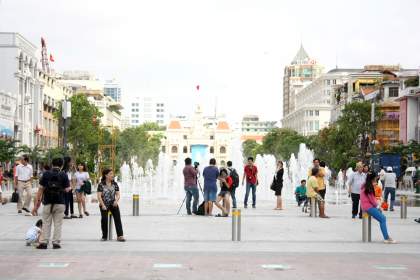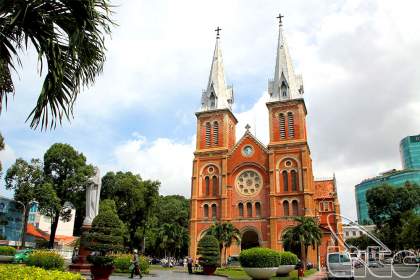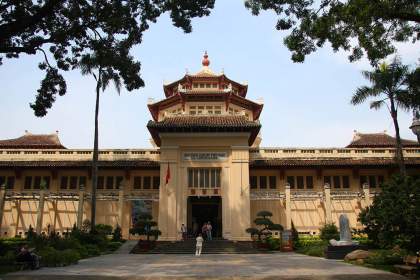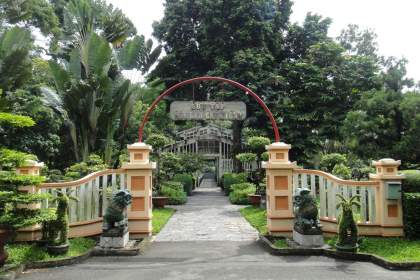SAI GON
Cu Chi Tunnels
Features: Tunnels is a battle map and creatively transformed military, Cu Chi people with hundreds of kilometers of the total length of branches spreading like cobwebs in the ground.
In 1948, to avoid the battles of the French sweeping and revolutionary cadres animal hide, hide documents, weapons, people in two communes of Tan Phu Trung and Phuoc Vinh An (Cu Chi) had dug the tunnel , short tunnel area by laterite clay with durability, avoid landslides. Then, the tunneling was expanded to other communes.
From 1961-1967, aimed at promoting guerrilla warfare against the sweeping battles, fierce raiding US - Wei, the people of Cu Chi Commune has connecting tunnel, the tunnel into a main road, call the road "backbone" and digging more tunnels connected with roads branching "backbone" to form a continuous tunnel system.
Only in the very primitive tools, the army and people of Cu Chi tunnels were created crisscrossing 250km underground, connecting the communes, hamlets together, can tunnel the Saigon River, a critical situation room can cross the river to the base of Ben Cat (Binh Duong). Tunnels are also equipped with the stopper to prevent toxic chemicals, sculpted air vents to the surface for air, above the extrusion disguised as termite mounds. Stores up and down the tunnels are designed to sniper gun emplacements versatile layout around trenches, fighting emplacements, tunnels husband, nail holes, anti-tank mines and pits rim anti-aircraft munitions launcher online straight.
Tunnels from 3-10m depth, consists of 3 floors. 3m above the ground floor 1, withstand the destructive power of bullets, artillery, the weight of armored tanks. 2 floors above the ground 5m, stand the destructive power of smaller bombs. 3 ground floor from 8 to 10 meters is a safe haven. Place up and down between floors with secret hatch covers. Inside the tunnel are arranged like a miniature village with infirmary; Hoang Cam kitchen (stove smoke hid in the soil); underground wells providing drinking water for the entire tunnel system; weapons storage areas, food and drinking water; Meeting areas; nurture wounded area; shelter; Cinema district ...
Since 1968, continuous enemy opened the fierce raid raiding Cu Chi. However, the tunnel system has been strengthened and become a gathering place for the legions, the main unit enters the liberation of Saigon, ending win the war against the United States on 30/4/1975 .
Cu Chi Tunnels are preserved in two locations were: Ben Duoc tunnels (used to be the base of the Party Committee, the High Command of Military Zone Sai Gon - Cho Lon - Gia Dinh) in Phu Hiep Hamlet, Phu My Hung and local Ben Dinh Tunnels (former base in Cu Chi district Commissioner) at Ben Dinh hamlet, Nhuan Duc commune.
When visiting the land was dubbed "iron land contract", visitors will find the guides as wartime costumes (men dressed liberation, camouflage hat; her three women dressed in black, Riding bandanna, wearing rubber sandals) at the same time have the opportunity to experience life underground tunnel as the true residents before.
Ben Duoc tunnels and Ben Dinh has been recognized as historic national culture in 1979 and 2004.
Maybe you are interested
Walking Street Nguyen Hue
Date posted: 09/01/2017French colonial period, Nguyen Hue Street is the Fabric Market canal leading from the Saigon River (Bach Dang Wharf today) to make West Palace Affairs (now the...
Notre Dame Cathedral
Date posted: 09/01/2017Church construction was started in 1877 to house the ceremony for French Catholics and inaugurated in 1880 under the name of the State church built by the...
Vietnam History Museum - City. Ho Chi Minh
Date posted: 09/01/2017Vietnam Museum of City History. Ho Chi Minh was built in 1929, its precursor is the Museum de la Brosse Blanchard. From 1929 to 1956 exhibiting ancient art...
Zoo
Date posted: 09/01/2017Zoo and Botanic garden originally built by the French in 1864, according to the botanical garden planning Emperor Louis XIII of France at the time, to place...
-

Samuel Pan (Mr)
Director
-

Bích Ngọc (Ms)
Tour Operator (Book phòng Khách sạn)
-

Tường Vũ (Mr)
Accounting Manager
-

Hannah Vo
Tour Operator
-
 DA NANG - HOI AN - BANA HILLS - CAM THANH ISLAND
Price: Call
DA NANG - HOI AN - BANA HILLS - CAM THANH ISLAND
Price: Call
-
 HO CHI MINH CITY – MEKONG DELTA – HANOI CITY – NINH BINH PROVINCE – HALONG BAY
Price: 501USD
HO CHI MINH CITY – MEKONG DELTA – HANOI CITY – NINH BINH PROVINCE – HALONG BAY
Price: 501USD
-
![[4D3N] EXCURSION TO ISLAND - DISCOVER CULTURE AND CUISINE OF NHA TRANG (HOTELS INCLUDED)](https://ziontour.com.vn/images/116945892365256100841.jpg) [4D3N] EXCURSION TO ISLAND - DISCOVER CULTURE AND CUISINE OF NHA TRANG (HOTELS INCLUDED)
Price: 192USD
[4D3N] EXCURSION TO ISLAND - DISCOVER CULTURE AND CUISINE OF NHA TRANG (HOTELS INCLUDED)
Price: 192USD
-
 4D3N NORTHWEST ROUTE TOUR: HANOI - MOC CHAU - DIEN BIEN - SAPA
Price: 194USD
4D3N NORTHWEST ROUTE TOUR: HANOI - MOC CHAU - DIEN BIEN - SAPA
Price: 194USD
-
![[2D2N] HA NOI - HA GIANG - YEN MINH - DONG VAN](https://ziontour.com.vn/images/116934701996323100841.png) [2D2N] HA NOI - HA GIANG - YEN MINH - DONG VAN
Price: 92USD
[2D2N] HA NOI - HA GIANG - YEN MINH - DONG VAN
Price: 92USD

















